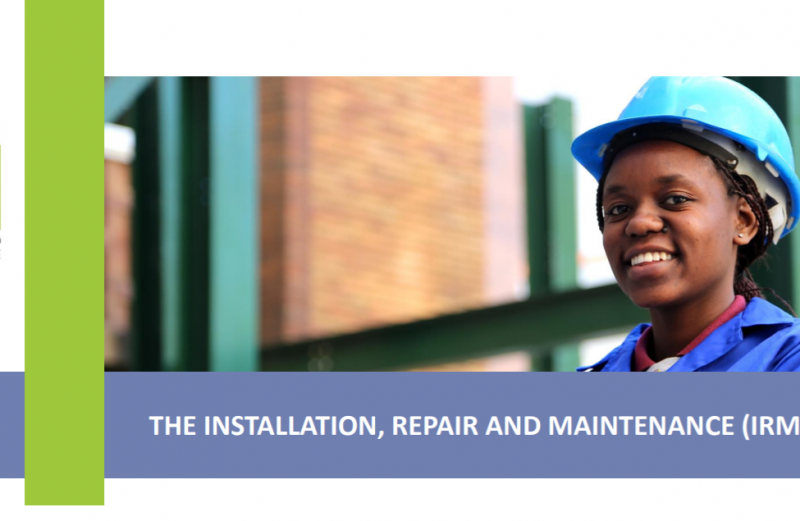
Institution: Harambee Youth Employment Accelerator and the National Business Initiative (NBI)
The South African economy faces a massive skills shortage in the technical and artisanal skills needed to support infrastructure development and economic growth. Traditional formal job opportunities are too few, and the system for post-school education and training pathways is inflexible and difficult to access. Also, artisanal development aims at an endpoint of specialist artisanal skills, suitable for large corporates in the industrial sector. But many other sectors, often powered by small or medium enterprise (SMEs) which make up a large number of potential employers, require a ‘missing middle’ lower level of generalist practical skills (such as ‘the handyman’).
Harambee Youth Employment Accelerator (a not-for-profit social enterprise), the National Business Initiative (NBI), together with government and other ecosystem partners, began the three-year IRM pilot programme in August 2018, to respond to the challenges sketched. The initiative is a demonstration of the types of public-private partnerships needed to address skills development, employability and self employment pathways at scale and for inclusiveness.
The initiative targets those exiting technical high schools or TVET (technical and vocational education and training) colleges with at least some basic technical skills. It aims to unlock entry-level opportunities in the areas of Installation, Repair, and Maintenance across different sectors, including those that use green or renewable technologies.
Our Approach
Year 1 (2018 – 2019) will serve as proof of concept, with succeeding years aimed at tracking graduates and integrating the approach into the public delivery system. The intention is to create a scalable and sustainable model to develop mid-level technical occupations.
The intervention will secure employer demand for IRM opportunities across multiple sectors; catalyzing demand-side opportunities while working with the supply side to source, match and effectively prepare candidates to access these opportunities.
The programme is adaptable to suit different needs, depending on the IRM role for which the candidate is preparing. It also provides options for exit points following the on-the-job training. These include (i) employment in a formal capacity as a junior IRM technician (an assistant to a qualified artisan or technician) or a junior artisan (after completing a trade test); (ii) self-employment as an independent contractor or proprietor; or (iii) small business entrepreneur.

The programme is 8 to 10 weeks bridging the gap between engineering theory and a work readiness element in terms of practical skills and work behaviours; after that a minimum of 12 months of on-the-job training.
Beyond the training programme, candidates will get support into the workplace training component, and for their post-programme decisions and next steps.
Collaboration is an essential aspect of the work, with synergistic relationships and benefits for all stakeholders (for example, industry recognition and buy-in).
Key Results
Although the IRM pilot is at an early point in its development (as of April 2019) some results can be noted:
The curriculum and delivery model has been developed and implemented with two student cohorts.
Two hundred students in the two cohorts have gone through the programme; 178 of these gained employment with the help of programme partners, while 22 found employment on their own.
The 100% employment rate so far confirms the original hypothesis around the need for lower level technical skills and suggests that employers are prepared to trust the process and the quality of the graduates produced.
The oversight committees and reference groups made up of key partners such as government are in place.
Lessons Learnt (Success Factors & Challenges)
Partners have recognised the need for a flexible curriculum, and resulting in adaptations. The curriculum is evolving towards a modular approach which builds on existing materials and structures, thereby delivering maximum effect with minimum inputs. The curriculum development approach could serve as a model for future iterations of this kind of programme.
Work-seeking skills need to be integrated into the programme to support the ultimate aim of self-placement.
Working with multiple stakeholders requires time, to nurture relationships with partners that hold similar but sometimes divergent views.
MOVING FORWARD
In Year 1 private colleges will provide the delivery model for the pilot.
In year 2 the public TVET colleges will deliver alongside the private colleges, to improve capacity to respond to industry needs.
In Year 3 the implementing partners will take on more of a quality assurance role.
Over these three years, the IRM initiative seeks to place 7,500 candidates into workplace opportunities, with 80% of these converting to employment, 30% of which will be self-employment.
The IRM programme is based on the assumption that going to scale involves integrating this approach into the public TVET system, supported by industry confidence in the employability of TVET graduates.
RESOURCES
https://www.sowetanlive.co.za/sundayworld/news/2018-12-11-gauteng-youth-get-skilled/


